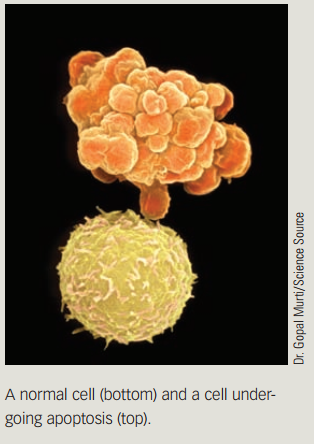Comparison of Apoptosis and Necrosis
Apoptosis is not the only means by which a cell can die, but it is the neatest way. Apoptosis is a controlled, intentional, tidy way of removing individual cells that are no longer needed or that pose a threat to the body. The other form of cell death, necrosis (meaning “making dead”), is uncontrolled, accidental, messy murder of useful cells that have been severely injured by an agent external to the cell, as by a physical blow, O2 deprivation, or disease. For example, heart muscle cells deprived of their O2 supply by complete blockage of the blood vessels supplying them during a heart attack die as a result of necrosis . Apoptosis is an energy-dependent process, whereas necrosis does not require energy.
Even though necrosis and apoptosis both result in cell death, the steps involved are different. In necrosis the dying cells are passive victims, whereas in apoptosis the cells actively participate in their deaths. In necrosis, the injured cell loses the integrity of its plasma membrane and cannot pump out Na1 as usual. As a result, water streams in by osmosis, causing the cell to swell and rupture. Typically, in necrosis the insult that prompted cell death injures many cells in the vicinity, so many neighboring cells swell and rupture together. Release of intracellular contents into the surrounding tissues.

By contrast, apoptosis targets individual cells for destruction, leaving the surrounding cells intact. A condemned cell signaled to commit suicide detaches itself from its neighbors and then shrinks instead of swelling and bursting. The cell’s mitochondria become leaky, permitting cytochrome c to leak out into the cytosol. Cytochrome c, a component of the electron transport system, usually participates in oxidative phosphorylation to produce ATP. Outside its typical mitochondrial environment, however, cytochrome c activates normally inactive intracellular protein-cutting enzymes, the caspases, which kill the cell from within. The unleashed caspases act like molecular scissors to systematically dismantle the cell. Snipping protein after protein, they chop up the nucleus, disassembling its life essential DNA, then break down the internal shape-holding cytoskeleton, and finally fragment the cell into disposable membrane enclosed packets (see accompanying photo).
Source : Physiology Sherwood